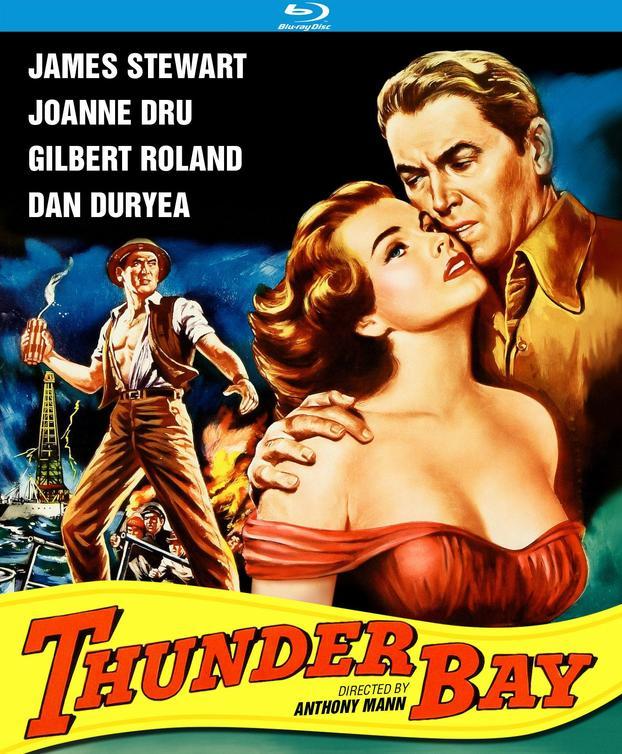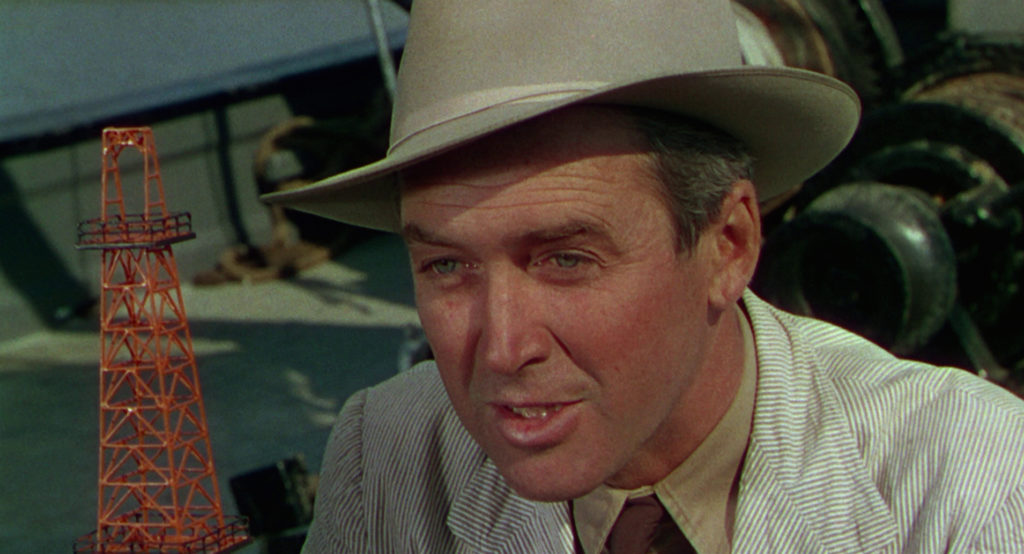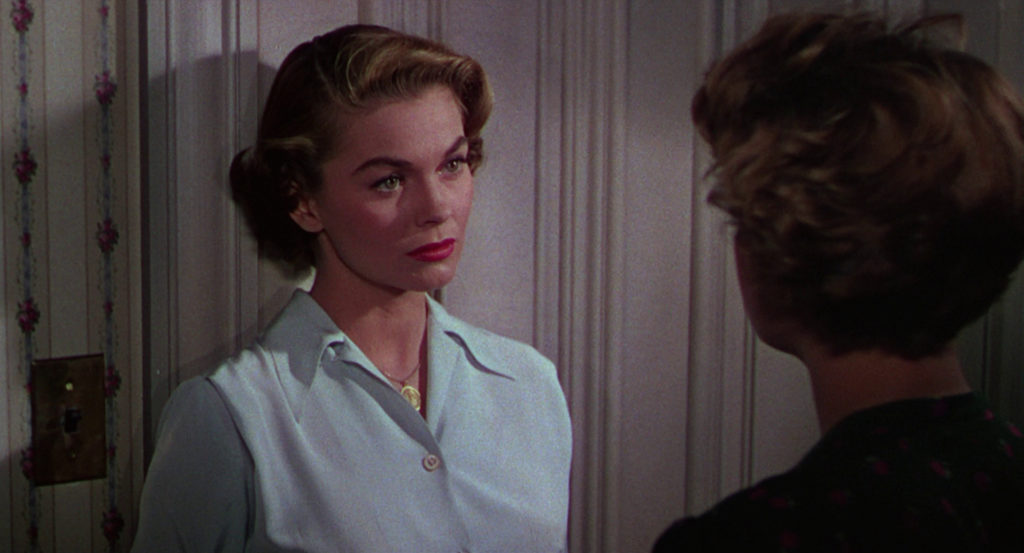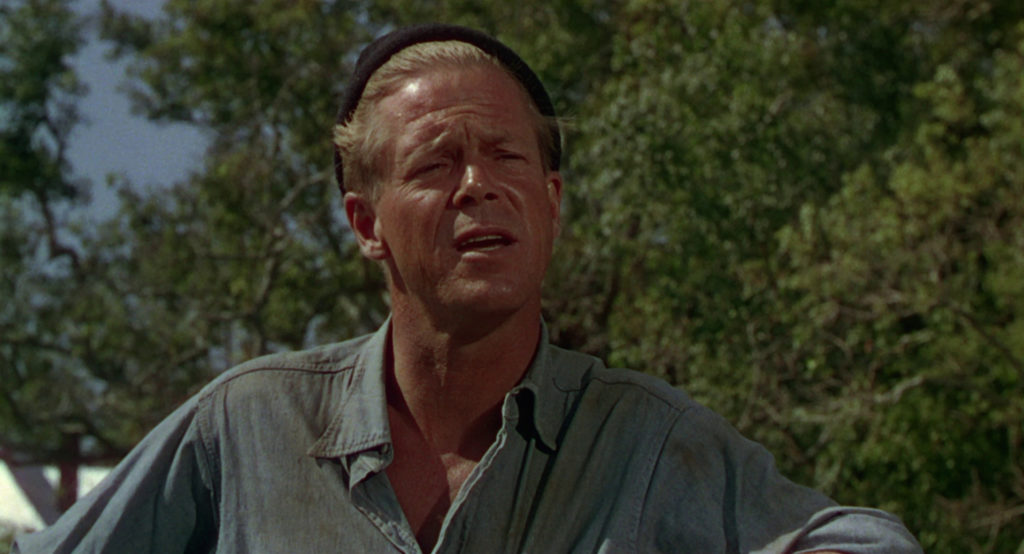Mann’s Man Stewart Builds Rig In The Gulf, Warns There May Be Blood…
DIRECTED BY ANTHONY MANN/1953
STREET DATE: JULY 9, 2019/KINO LORBER STUDIO CLASSICS

One of eight Stewart-Mann joints, but not a Western…more of a Southern. Set along the coast of Louisiana, Stewart plays Steve Martin, a wild and crazy wildcatter down on his luck after a long string of failed attempts to bring off his big ideas, the biggest of which is to build the first offshore oil rig in the Gulf of Mexico, convinced an unending supply of crude awaits. His litany of failures paints the picture of a rank huckster to any new mark he approaches, but he’s the archetypal self-made American man with a dream and he’s not about to give up now. At last, he and his partner, Johnny Gambi (the naturally smarmy Dan Duryea), successfully hook a money man (Jay C. Flippen), also down on his luck, into financing the gambit, and they’re off and running, with a story mandate to begin pumping crude inside the three months it’ll take for the money to dry up.
There’s only one problem. They’re all strangers in these parts and the locals have rallied in understandable protest against what they see as a threat to their long-established shrimping livelihood – but they’re presented here as the pesky rabble that confounds the hero. So it’s ten minutes in and the movie’s already become accidentally tone deaf to the modern viewer, the general attitude toward the oil business having flipped over the decades. If this were made today, the film would be squarely on the side of the small town and the dangers to the environment of deep oil drilling, especially the killing of millions of shrimp and the devastation of an entire region’s main source of income. The bad guys would get the two-dimensional treatment and Tom Hanks would be the town mayor who spends his last breath defending the little man against a faceless corporation. Here, though, our beloved Stewart is the face of the monolithic corporation battling the small-mindedness of backward hicks – in one scene actually throwing sticks of lit dynamite into a crowd to keep them at bay.

Stewart’s very Stewart-like appeal to the townspeople, gathered later as a mob with the intention of killing him and tearing the rig apart, is full of now-cringy logic: “There’s oil down there and we need it. All of us. Without oil this country would stop. It would die.” The implications were true at the time, and this film is a time capsule of a bygone American dogma, one that still thrives in certain quadrants, but one that’s been slowly superseded by alternatives so obtainable that they have the power to render even a Jimmy Stewart speech unwatchable. But the rhetoric at least comes to us honestly. After developing an interest in oil drilling, then investing money in some endeavors, Stewart wanted to make a movie that preached the safety of the process. The movie became a passion project, so that when Martin makes his case for the Gulf rig to love interest Joanne Dru, it could be Stewart himself drawling out his motivation: “Millions of years ago oil was formed by things dying… Now if I can reach down there and bring up the results of all those millions of years and make them work for the present and the future, then I’ve done something haven’t I? I’ve sort of… put all time together.” In typically sublime form, Stewart makes the paragraph sing, but his grandiosity and self-hero worship only make the overall tone weirder.

The movie has incredibly high production value, mostly in the form of the rig itself – most of the film was shot on location in Morgan City, Louisiana, and on an actual working rig thirty miles out in the Gulf. It makes for some great shots, but the disc doesn’t do them many favors. While Kino Lorber’s preserved the three-track sound, emulating as best it can Universal’s first ever use of stereophonics, the sad Technicolor looks like it’s doubling up on itself, giving certain scenes a blurry cast – this may have something to do with the studio green-lighting it as a 3D production, then changing their mind half way through. The result is many shots sporting the vague look of 3D with the glasses off.
Another asterisk on this inaugural Blu-ray edition is the aspect ratio: the film was composed and shot in 1.37, then Universal cropped the top and bottom willy-nilly on its first release to catch up to the industry-wide push for widescreen. While that’s the version everyone saw, it’s not the version that was actually made, so purists will balk. Previous DVD releases have the original ratio – and any comparison reveals immediately the improvement 1.37 makes, especially when the crop is coupled with the overly yellow/green tint of Kino Lorber’s transfer.
The disc’s commentary track features ever-intrepid Toby Roan’s typical deep-dive into cast and crew biographical sketches. He saves some time to discuss a few, but not all, of the issues referred to above, but there’s a general feeling that this movie, featuring such a unique milieu for its high profile top-of-the-bill names (Stewart and Mann), could use a more thorough discussion of themes and style over names and dates.

All the negatives aside, this is an entertaining, muscley, Hawksian story of men on a mission, with everyman Stewart injecting his ad hoc family of beleaguered oil grunts with a shot of earnest, can-do enthusiasm. Part of the charm of the movie is the love-hate friendship between money-brains Stewart and street-wise Duryea, leading ultimately to a fist fight on the rig – lanky v. lanky – that turns chummy almost immediately afterward. It’s that sense of tough men fighting it out in the shadow of mammoth machines that gives the movie its credibility as a masculine adventure, while the same machinery, especially the oil derrick protruding two hundred feet into the sky, that gives conversations between Stewart and Dru a certain Freudian dimension that’s hard to see as anything but intentional.
Meanwhile, Mann lets disturbed motives enter a sensible storyline like no one else. It’s never twisted like, say, Hitchcock, but a level-headed and logical descent. Stewart’s shambling con-man, which is how he’s portrayed at the top of the story, by movie’s end becomes a manic control freak, putting fists and dynamite to any who come too close to sabotaging his dream. It’s that mix of stammer and shocking anger that Stewart does well, but that comes through most vividly in Mann films. Mann was hired by free agent Stewart based on their successful plumbing of Stewart’s capacity for quasi-lurid fury in their three previous films (all dark Westerns: Winchester ’73, Bend of the River, The Naked Spur), and it serves the story well. Without the dark angles, the adventure and romance wouldn’t withstand those lashing, hurricane-force winds.
All images courtesy of DVD BEAVER.

